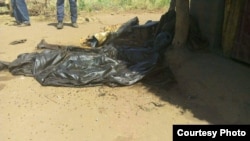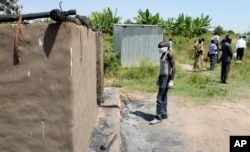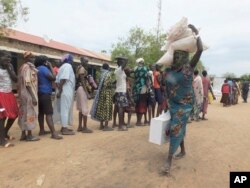The identity of the man is unknown. The circumstances of his passing are unclear. All that appears certain is that the man suffered a hideous, violent death.
The photos of the man were taken on or about April 12, a little more than a week after men wearing uniforms of the South Sudanese army entered Parjok, a small town near South Sudan's border with Uganda, and killed up to 16 people, many of them execution-style.
The photographer, who did not want to be identified, snapped pictures in the aftermath. Some show the remains of charred, burned-out huts. Another shows local residents, possibly homeless, sitting in the street with a few belongings, including a muddy bicycle.
The most disturbing photos show the remains of the unidentified man, left for dead outside a hut. Most of his skin and muscles have been burned away, leaving an almost bare skeleton on the dusty ground. In the back of his skull, smack in the center, there is a sizable hole. It looks bullet-sized.
Observatory group
The photo was sent to VOA's South Sudan in Focus by the South Sudan Human Rights Observatory Group.
The volunteer group, formed by South Sudanese lawyers, journalists and academics a month ago, collects information and images that document abuses against civilians, who have suffered the brunt of the violence and atrocities committed during South Sudan's three-year-plus conflict.
One of the founders, Remember Miamingi, said the group had been "overwhelmed" by the volume of photos and witness testimony people sent from Parjok and the town of Wau, also the scene of recent fighting.
People used satellite phones and mobile phones to record "evidence of things as they were unfolding. We were shocked," Miamingi told VOA.
He said the group's work could be used to help investigative bodies, such as the U.N. Commission on Human Rights and the African Union Peace and Security Council.
It's important that the collected information is properly analyzed, "so that people who have shared this information with us can see that we are letting the world know what their personal experiences are," Miamingi said.
Individual experiences can get lost in the tales of misery that come out of South Sudan, where fighting has left huge parts of the country mired in chronic violence and spreading hunger that has reached famine levels in parts of Unity State, in the north of the country.
Neither side accepts blame
In phone interviews with VOA's Daybreak Africa, representatives of both sides — the government of President Salva Kiir and the opposition led by former Vice President Riek Machar — refused to take blame for the crisis.
"We are not violent. It is the government that is violent," said Lieutenant Colonel Lam Paul Gabriel of the Sudan People's Liberation Army-in Opposition (SPLA-IO). "We are on a strict order from Riek Machar not to engage the government in any attacks, so we have been on self-defense every single moment."
Some observers characterize the conflict as ethnic in nature, with Kiir's Dinka tribe trying to seize property and power from Machar's Nuer tribe and other non-Dinka groups. Gabriel said there is a "genocide" going on in the areas of the country inhabited by the Nuer ethnic group.
Ateny Wek Ateny, a spokesman for the Kiir government, denied there was an ethnic aspect to the fighting. He said South Sudanese of various ethnicities are "happily living side by side."
"The government of South Sudan is only defending itself while it is attacked by the bandits who are armed and trying to cause havoc in the country," Ateny said. "Why would the government of South Sudan fight its own people?"
But Human Rights Watch and the U.N. Human Rights Council have released reports putting blame for the violence on the government. The U.N. report said the army and National Security Service have attacked the Nuer and other non-Dinka ethnic groups who they believe are helping the rebels.
Aid blocked
The government also uses food as a weapon, according to the U.N. The Human Rights Council said that since December 2016, the National Security Service has prevented eight aid organizations from delivering assistance to rebel-controlled areas.
The army apparently was behind the killings in Parjok on April 3. Residents said soldiers entered the town and demanded to know the whereabouts of rebel fighters, according to a report from the U.N. refugee agency.
An army deputy spokesman, Brigadier General Santo Domic, told South Sudan in Focus that troops killed people whom he described as "bandits," who he said were looting buildings and killing civilians.
A spokesman for the U.N. refugee agency, citing witnesses, said the town had come under an indiscriminate attack by the South Sudanese armed forces.
Some witnesses saw people shot at close range, one of them being the man left for dead on a Parjok street.
Most of Parjok's residents fled in the wake of the attack, making it hard to determine why the man was targeted for such a grisly death, his remains being left to rot in the hot sun.
VOA’s Salem Solomon contributed to this report.



